Extraordinarily High Organic Matter Enrichment in Upper Permian Wujiaping Formation in the Kaijiang-Liangping Trough, Sichuan Basin
Abstract
:1. Introduction
2. Geological Settings
3. Materials and Methods
3.1. Sample Testing
3.2. Data Processing
| Depth m | TOC % | Fe2O3 % | Al2O3 % | SiO2 % | K2O % | CaO % | TiO2 % | MgO % | P2O5 % | MnO % | Na2O % | Ba ug/g | V ug/g | Sr ug/g | Cr ug/g | U ug/g | Cu ug/g | Cd ug/g | Mo ug/g | Co ug/g | Ni ug/g | Zn ug/g | TCP | C | CIA |
|---|---|---|---|---|---|---|---|---|---|---|---|---|---|---|---|---|---|---|---|---|---|---|---|---|---|
| 4328 | 15.00 | 2.45 | 2.01 | 52.32 | 0.90 | 15.25 | 0.14 | 0.38 | 0.05 | 183.00 | 0.44 | 129.00 | 1270.00 | 4170.00 | 210.00 | 27.40 | 65.00 | 120.00 | 398.00 | 9.30 | 187.50 | 126.00 | 0.16 | 0.43 | 61.41 |
| 4329 | 14.00 | 2.21 | 1.95 | 49.84 | 0.92 | 12.37 | 0.15 | 0.34 | 0.06 | 190.00 | 0.37 | 165.00 | 1120.00 | 3560.00 | 190.00 | 25.60 | 120.38 | 95.00 | 289.61 | 10.29 | 186.25 | 150.00 | 0.34 | 0.45 | 60.64 |
| 4330 | 15.26 | 6.32 | 1.96 | 46.87 | 1.32 | 11.29 | 0.21 | 0.29 | 0.45 | 265.00 | 0.65 | 187.00 | 1320.00 | 1560.00 | 200.00 | 18.60 | 160.93 | 80.00 | 256.31 | 9.74 | 230.00 | 160.00 | 0.29 | 1.15 | 62.93 |
| 4331 | 10.00 | 10.32 | 4.31 | 37.41 | 2.21 | 13.25 | 0.35 | 0.52 | 0.03 | 276.00 | 0.70 | 191.50 | 1495.00 | 1675.00 | 310.00 | 11.65 | 185.50 | 17.20 | 156.00 | 22.00 | 245.00 | 221.00 | 0.39 | 1.25 | 60.60 |
| 4332 | 6.00 | 3.87 | 4.28 | 39.18 | 2.32 | 14.31 | 0.22 | 0.28 | 0.03 | 290.00 | 0.56 | 187.00 | 980.00 | 1450.00 | 240.00 | 15.60 | 100.85 | 10.00 | 160.23 | 18.65 | 235.00 | 116.00 | 0.22 | 1.07 | 59.95 |
| 4333 | 12.31 | 1.40 | 1.62 | 56.64 | 0.73 | 14.60 | 0.12 | 0.39 | 0.24 | 358.00 | 0.33 | 106.50 | 786.00 | 1185.00 | 260.00 | 22.20 | 80.40 | 15.85 | 30.00 | 8.90 | 127.00 | 126.00 | 0.14 | 1.18 | 62.54 |
| 4334 | 13.26 | 2.21 | 1.69 | 49.27 | 0.95 | 15.30 | 0.08 | 0.36 | 0.69 | 350.00 | 0.34 | 110.00 | 790.00 | 1095.00 | 240.00 | 23.50 | 140.58 | 14.32 | 70.32 | 10.21 | 128.19 | 123.00 | 0.20 | 1.25 | 60.26 |
| 4335 | 14.36 | 1.32 | 2.12 | 48.92 | 1.03 | 10.89 | 0.11 | 0.27 | 0.76 | 980.00 | 0.31 | 148.00 | 620.00 | 860.00 | 290.00 | 32.30 | 143.66 | 10.00 | 82.38 | 11.23 | 213.34 | 127.00 | 0.27 | 2.07 | 63.55 |
| 4336 | 13.00 | 3.00 | 2.93 | 51.41 | 1.31 | 12.95 | 0.22 | 0.33 | 0.72 | 1060.00 | 0.53 | 154.00 | 592.00 | 882.00 | 380.00 | 38.80 | 155.50 | 10.00 | 73.30 | 12.90 | 217.00 | 140.00 | 0.24 | 2.16 | 62.94 |
| 4337 | 14.00 | 2.63 | 4.65 | 47.42 | 2.36 | 9.39 | 0.38 | 0.52 | 0.72 | 1660.00 | 0.50 | 250.00 | 361.00 | 572.00 | 340.00 | 21.10 | 214.00 | 6.03 | 17.10 | 23.90 | 357.00 | 363.00 | 0.41 | 3.30 | 65.39 |
| 4338 | 11.00 | 5.32 | 3.58 | 50.30 | 2.31 | 9.76 | 0.32 | 0.43 | 0.61 | 1520.00 | 0.29 | 213.00 | 410.00 | 680.00 | 320.00 | 20.42 | 180.29 | 7.23 | 16.25 | 20.14 | 321.31 | 320.00 | 0.57 | 2.88 | 60.22 |
| 4361 | 0.45 | 10.21 | 1.23 | 45.20 | 3.11 | 3.56 | 0.89 | 0.86 | 0.06 | 1890.00 | 0.37 | 220.00 | 390.00 | 580.00 | 130.00 | 2.60 | 190.36 | 0.15 | 4.36 | 38.65 | 98.00 | 160.00 | 0.28 | 3.17 | 52.82 |
| 4362 | 2.10 | 8.36 | 3.25 | 42.13 | 3.23 | 4.23 | 2.69 | 1.02 | 0.06 | 1560.00 | 0.58 | 215.00 | 380.00 | 390.00 | 110.00 | 1.96 | 185.26 | 0.25 | 3.69 | 41.25 | 79.36 | 158.00 | 1.05 | 3.55 | 52.49 |
| 4363 | 2.20 | 6.25 | 4.68 | 45.28 | 2.87 | 2.07 | 1.32 | 0.81 | 0.06 | 1763.00 | 0.61 | 201.00 | 160.00 | 340.00 | 130.00 | 2.13 | 90.36 | 0.23 | 3.28 | 45.62 | 61.28 | 169.00 | 1.16 | 3.97 | 66.64 |
| 4364 | 4.40 | 18.08 | 8.23 | 39.77 | 2.69 | 2.14 | 1.62 | 0.95 | 0.07 | 2280.00 | 0.60 | 208.00 | 165.00 | 296.00 | 120.00 | 2.20 | 58.30 | 0.18 | 3.68 | 53.10 | 78.40 | 171.00 | 1.66 | 6.80 | 74.94 |
| 4365 | 3.21 | 20.70 | 5.92 | 28.80 | 1.20 | 1.30 | 1.11 | 0.49 | 0.03 | 316.00 | 0.86 | 233.00 | 147.00 | 214.00 | 100.00 | 3.22 | 120.50 | 0.10 | 8.82 | 28.90 | 53.70 | 46.00 | 1.24 | 1.00 | 69.39 |
| 4366 | 4.26 | 4.32 | 9.68 | 29.67 | 1.98 | 1.25 | 3.26 | 0.27 | 0.03 | 450.00 | 0.92 | 290.00 | 132.00 | 320.00 | 240.00 | 6.36 | 110.00 | 0.20 | 5.68 | 24.56 | 80.00 | 45.00 | 2.99 | 1.23 | 74.35 |
| 4367 | 3.56 | 11.54 | 13.45 | 40.57 | 2.73 | 0.34 | 3.72 | 0.33 | 0.03 | 532.00 | 1.48 | 319.00 | 370.00 | 442.00 | 270.00 | 9.66 | 105.00 | 0.10 | 4.06 | 23.00 | 112.00 | 41.00 | 3.71 | 1.19 | 74.44 |
| 4368 | 4.00 | 5.65 | 13.40 | 45.10 | 3.54 | 0.44 | 3.82 | 0.51 | 0.10 | 61.00 | 1.16 | 337.00 | 386.00 | 477.00 | 280.00 | 6.59 | 100.00 | 0.23 | 8.57 | 31.30 | 123.00 | 55.00 | 3.78 | 2.54 | 76.25 |
| 4369 | 5.12 | 2.31 | 3.58 | 40.17 | 3.25 | 0.36 | 3.21 | 0.47 | 0.09 | 60.00 | 1.15 | 310.00 | 320.00 | 580.00 | 270.00 | 8.26 | 120.76 | 0.30 | 3.18 | 29.75 | 48.32 | 56.00 | 3.74 | 2.54 | 70.16 |
| Depth m | La | Ce | Pr | Nd | Sm | Eu | Gd | Tb | Dy | Y | Ho | Er | Tm | Yb | Lu | REE | EUEF | (La/Yb)N |
|---|---|---|---|---|---|---|---|---|---|---|---|---|---|---|---|---|---|---|
| 4328 | 12.90 | 24.00 | 3.11 | 12.20 | 2.55 | 0.49 | 2.37 | 0.36 | 2.18 | 16.10 | 0.45 | 1.33 | 0.19 | 0.69 | 0.19 | 79.70 | 1.35 | 0.74 |
| 4329 | 12.80 | 26.20 | 3.15 | 12.10 | 2.61 | 0.50 | 2.10 | 0.28 | 2.10 | 14.60 | 0.46 | 1.36 | 0.18 | 0.57 | 0.20 | 79.87 | 1.42 | 0.75 |
| 4330 | 13.60 | 28.90 | 3.68 | 14.30 | 2.47 | 0.21 | 1.96 | 0.40 | 2.32 | 13.70 | 0.50 | 1.45 | 0.30 | 0.86 | 0.25 | 85.61 | 1.11 | 0.62 |
| 4331 | 15.70 | 29.70 | 3.78 | 13.70 | 2.60 | 0.47 | 2.20 | 0.36 | 2.33 | 15.90 | 0.52 | 1.58 | 0.25 | 0.75 | 0.26 | 91.00 | 0.61 | 0.70 |
| 4332 | 14.80 | 30.20 | 3.92 | 15.30 | 2.30 | 0.50 | 2.30 | 0.31 | 2.10 | 16.30 | 0.57 | 1.60 | 0.28 | 0.72 | 0.30 | 92.36 | 0.36 | 0.69 |
| 4333 | 11.40 | 17.40 | 2.39 | 9.00 | 1.90 | 0.38 | 2.17 | 0.33 | 2.12 | 17.40 | 0.47 | 1.41 | 0.22 | 0.63 | 0.23 | 68.21 | 1.30 | 0.60 |
| 4334 | 10.80 | 18.50 | 2.68 | 12.30 | 1.91 | 0.60 | 2.15 | 0.36 | 2.36 | 15.70 | 0.30 | 1.35 | 0.30 | 0.90 | 0.28 | 71.03 | 1.84 | 0.55 |
| 4335 | 12.60 | 60.10 | 6.21 | 15.60 | 3.65 | 0.71 | 6.21 | 0.50 | 3.47 | 18.50 | 0.65 | 2.36 | 0.45 | 0.86 | 0.34 | 132.87 | 3.14 | 0.62 |
| 4336 | 29.40 | 61.50 | 7.13 | 28.50 | 6.40 | 1.30 | 7.02 | 1.05 | 6.60 | 49.60 | 1.37 | 3.69 | 0.48 | 1.03 | 0.45 | 207.43 | 2.46 | 0.40 |
| 4337 | 23.30 | 43.00 | 5.28 | 20.30 | 4.53 | 0.87 | 4.93 | 0.75 | 4.75 | 38.50 | 1.03 | 3.12 | 0.46 | 1.52 | 0.51 | 154.46 | 1.04 | 0.73 |
| 4338 | 24.60 | 44.30 | 6.23 | 19.40 | 3.92 | 0.90 | 5.30 | 0.79 | 4.32 | 35.20 | 1.20 | 3.20 | 0.50 | 1.42 | 0.61 | 153.57 | 1.49 | 0.55 |
| 4361 | 60.30 | 50.30 | 10.32 | 58.70 | 6.70 | 1.20 | 6.30 | 1.20 | 4.30 | 58.20 | 1.89 | 4.25 | 0.80 | 1.41 | 1.02 | 270.09 | 10.43 | 0.58 |
| 4362 | 70.50 | 150.20 | 15.62 | 60.10 | 9.20 | 1.30 | 8.45 | 1.36 | 10.20 | 57.90 | 1.80 | 4.68 | 0.87 | 3.10 | 1.00 | 398.81 | 3.68 | 0.97 |
| 4363 | 69.60 | 80.20 | 16.31 | 61.30 | 10.62 | 2.15 | 10.61 | 1.70 | 11.32 | 60.30 | 2.10 | 5.30 | 0.90 | 2.55 | 1.30 | 339.19 | 3.12 | 0.92 |
| 4364 | 72.90 | 155.50 | 17.00 | 62.70 | 12.90 | 2.76 | 12.25 | 1.91 | 11.40 | 62.50 | 2.31 | 6.55 | 0.91 | 2.49 | 0.85 | 428.24 | 1.86 | 0.93 |
| 4365 | 95.70 | 208.00 | 24.20 | 95.60 | 20.20 | 2.49 | 19.10 | 3.18 | 18.95 | 97.90 | 3.70 | 9.84 | 1.29 | 2.64 | 1.15 | 609.06 | 2.34 | 0.92 |
| 4366 | 71.30 | 148.00 | 18.45 | 72.00 | 15.65 | 3.62 | 13.70 | 2.30 | 14.10 | 73.90 | 2.79 | 7.87 | 1.06 | 3.53 | 0.96 | 452.22 | 1.54 | 0.90 |
| 4367 | 76.30 | 130.50 | 19.62 | 76.20 | 14.52 | 2.98 | 14.60 | 2.31 | 13.65 | 74.20 | 2.68 | 7.68 | 1.25 | 2.45 | 0.85 | 443.79 | 1.50 | 0.80 |
| 4368 | 88.80 | 191.50 | 22.40 | 86.10 | 18.35 | 4.69 | 15.65 | 2.33 | 13.90 | 75.00 | 2.78 | 7.72 | 1.06 | 2.95 | 0.93 | 537.70 | 1.94 | 0.86 |
| 4369 | 89.00 | 201.00 | 23.60 | 85.70 | 17.65 | 4.10 | 14.00 | 2.35 | 14.20 | 76.40 | 2.76 | 7.80 | 1.30 | 2.95 | 0.98 | 547.29 | 5.60 | 1.00 |
| UCC | 30.00 | 7.10 | 26.00 | 4.50 | 0.88 | 3.80 | 0.64 | 3.80 | 0.64 | 3.50 | 0.80 | 2.30 | 0.33 | 2.20 | 0.32 | 86.81 |
4. Results
4.1. Petrological Characteristics
4.2. Geochemical Characteristics
4.2.1. Total Organic Carbon
4.2.2. Major and Trace Elements
4.2.3. Rare Earth Elements
5. Discussion
5.1. Factors Affecting OM Enrichment
5.1.1. Redox Condition
5.1.2. Paleoproductivity
5.1.3. Deposition Rate
5.1.4. The Relation among TOC, Paleoproductivity, and Redox
5.2. Paleogeography Factors Causing Productivity and Anoxic Environment Changes
5.2.1. Reasons for High Productivity
5.2.2. Sea Level Change
5.3. Enrichment Pattern of EHOMC
6. Conclusions
Author Contributions
Funding
Institutional Review Board Statement
Informed Consent Statement
Data Availability Statement
Conflicts of Interest
References
- Pang, Q.; Zhang, X.H.; Chen, C.; Gao, Z.L.; Shan, S.J.; Chen, Y.G.; You, J.; Hu, C.W.; Hu, G. Extraordinarily high organic matter enrichment during the late Guadalupian in northwestern Sichuan basin, China. J. Pet. Sci. Eng. 2022, 210, 110058. [Google Scholar] [CrossRef]
- Scott, C.; Slack, J.F.; Kelley, K.D. The hyper-enrichment of V and Zn in black shales of the Late Devonian-Early Mississippian Bakken Formation (USA). Chem. Geol. 2017, 452, 24–33. [Google Scholar] [CrossRef] [Green Version]
- Curtis, J.B. Fractured shale-gas systems. AAPG Bull. 2002, 86, 1921–1938. [Google Scholar]
- Xia, G.Q.; Mansour, A.; Gentzis, T.; Li, G.J.; Carvajal-Ortiz, H.; Ocubalidet, S.; Yi, F.; Yun, C.; Yi, H.S. Depositional paleoenvironment and source rock characterization across the Toarcian Oceanic Anoxic Event from the eastern Tethys, Tibet, SW China. Int. J. Coal Geol. 2021, 243, 103780. [Google Scholar] [CrossRef]
- Liang, D.G.; Guo, T.L.; Bian, L.Z.; Chen, J.; Zhao, Z. Some progresses on studies of hydrocarbon generation and accumulation in marine sedimentary regions, Southern China (Part 3): Controlling factors on the sedimentary facies and development of Palaeozoic marine source rocks. Mar. Orig. Pet. Geol. 2009, 14, 1–19. [Google Scholar]
- Dong, D.Z.; Gao, S.; Huang, J.L.; Guan, Q.; Wang, S.; Wang, Y. A discussion on the shale gas exploration & development prospect in the Sichuan Basin. Nat. Gas Ind. 2014, 34, 1–15. [Google Scholar]
- Dong, D.Z.; Cheng, K.M.; Wang, Y.M.; Li, X.J.; Wang, S.J.; Huang, J.L. Forming conditions and characteristics of shale gas in the Lower Paleozoic of the Upper Yangtze region, China. Oil Gas Geol. 2010, 31, 288–299. [Google Scholar]
- Wei, Z.; Wang, Y.; Wang, G.; Sun, Z.; Xu, L. Pore characterization of organic-rich Late Permian Da-long Formation shale in the Sichuan Basin, southwestern China. Fuel 2018, 211, 507–516. [Google Scholar] [CrossRef]
- Zhao, P.R.; Gao, B.; Guo, Z.F.; Wei, Z.H. Exploration potential of marine-continental transitional and deep-water shelf shale gas in Upper Permian, Sichuan basin. Pet. Geol. Exp. 2020, 42, 335–344. [Google Scholar]
- Demaison, G.J.; Moore, G.T. Anoxic environments and oil source bed genesis. AApG Bull. 1980, 64, 1179–1209. [Google Scholar] [CrossRef]
- Pedersen, T.F.; Calvert, S.E. Anoxia vs. productivity: What controls the formation of organic-carbon-rich sediments and sedimentary rocks? Aapg Bull. 1990, 74, 454–466. [Google Scholar]
- Bruyevich, S. Rates of mineralization of suspended organic carbon in the low latitudes of the Pacific during the pre-depositional stage. Geochemistry 1963, 3, 349–352. [Google Scholar]
- Mort, H.; Jacquat, O.; Adatte, T.; Steinmann, P.; Föllmi, K.; Matera, V.; Berner, Z.; Stüben, D. The Cenomanian/Turonian anoxic event at the Bonarelli Level in Italy and Spain: Enhanced productivity and/or better preservation? Cretac. Res. 2007, 28, 597–612. [Google Scholar] [CrossRef] [Green Version]
- Mansour, A.; Wagreich, M.; Gier, S.; Gentzis, T.; Kloetzli, U.; Tahoun, S.S. Elewa AM. Climate variability and paleoceanography during the Late Cretaceous: Evidence from palynology, geochemistry and stable isotopes analyses from the southern Tethys. Cretac. Res. 2021, 126, 104831. [Google Scholar] [CrossRef]
- Sageman, B.B.; Murphy, A.E.; Werne, J.P.; Ver Straeten, C.A.; Hollander, D.J.; Lyons, T.W. A tale of shales: The relative roles of production, decomposition, and dilution in the accumulation of organic-rich strata, Middle–Upper Devonian, Appalachian basin. Chem. Geol. 2003, 195, 229–273. [Google Scholar] [CrossRef]
- Smith, M.G.; Bustin, R.M. Production and preservation of organic matter during deposition of the Bakken Formation (Late Devonian and Early Mississippian), Williston Basin. Palaeogeogr. Palaeoclimatol. Palaeoecol. 1998, 142, 185–200. [Google Scholar] [CrossRef]
- Wignall, P.B.; Sun, Y.; Bond, D.P.; Izon, G.; Newton, R.J.; Védrine, S.; Widdowson, M.; Ali, J.R.; Lai, X.; Jiang, H.; et al. Volcanism, Mass Extinction, and Carbon Isotope Fluctuations in the Middle Permian of China. Science 2009, 324, 1179–1182. [Google Scholar] [CrossRef]
- Zhang, B.; Wignall, P.B.; Yao, S.; Hu, W.; Liu, B. Collapsed upwelling and intensified euxinia in response to climate warming during the Capitanian (Middle Permian) mass extinction. Gondwana Res. 2021, 89, 31–46. [Google Scholar] [CrossRef]
- Shen, S.Z.; Yuan, D.X.; Henderson, C.M.; Wu, Q.; Zhang, Y.C.; Zhang, H.; Mu, L.; Ramezani, J.; Wang, X.D.; Lambert, L.L.; et al. Progress, problems and prospects: An overview of the Guadalupian Series of South China and North America. Earth-Sci. Rev. 2020, 211, 103412. [Google Scholar] [CrossRef]
- Bian, L.; Schovsbo, N.H.; Chappaz, A.; Zheng, X.; Nielsen, A.T.; Ulrich, T.; Wang, X.; Dai, S.; Galloway, J.M.; Małachowska, A.; et al. Molybdenum-uranium-vanadium geochemistry in the lower Paleozoic Alum Shale of Scandinavia: Implications for vanadium exploration. Int. J. Coal Geol. 2021, 239, 103730. [Google Scholar] [CrossRef]
- Tibiletti, M.G.; Trubia, M.; Ponti, E.; Sessa, L.; Acquati, F.; Furlan, D.; Bernasconi, B.; Fichera, M.; Mihalich, A.; Ziegler, A.; et al. Physical map of the D6S149-D6S193 region on chromosome 6Q27 and its involvement in benign surface epithelial ovarian tumours. Oncogene 1998, 16, 1639. [Google Scholar] [CrossRef] [PubMed] [Green Version]
- Feng, Z.; Yang, Y.; Jin, Z.; He, Y.; Wu, S.; Xin, W.; Bao, Z.; Tan, J. Lithofacies paleogeography of the Permian of South China. Acta Sedimentol. Sin. 1996, 14, 1–11. [Google Scholar]
- Wang, X.Z.; Li, B.; Yang, X.Y.; Wen, L.; Xu, L.; Xie, S.Y.; Du, Y.; Feng, M.Y.; Yang, X.F.; Wang, Y.P.; et al. Characteristics of “Guangyuan-Wangcang” trough during late Middle Permian and its petroleum geological significance in northern Sichuan Basin, SW China. Pet. Explor. Dev. 2021, 48, 562–574. [Google Scholar] [CrossRef]
- Xiao, W.; Zhang, B.; Yao, Y.J.; Wang, Y.; Yang, H.Y.; Yang, K. Lithofacies and sedimentary environment of shale of Permian Longtan Formation in eastern Sichuan Basin. Lithol. Reserv. 2022, 34, 152–162. [Google Scholar]
- Taylor, S.R. The abundance of chemical elements in the continental crust-A new table. Geochim. Cosmochim. Acta 1964, 28, 1273–1285. [Google Scholar] [CrossRef]
- Wedepohl, K.H. Environmental influences on the chemical composition of shales and clays. Phys. Chem. Earth 1971, 8, 305–333. [Google Scholar] [CrossRef]
- Tribovillard, N.; Algeo, T.J.; Lyons, T.; Riboulleau, A. Trace metals as paleoredox and paleoproductivity proxies: An update. Chem. Geol. 2006, 232, 12–32. [Google Scholar] [CrossRef]
- Turekian, K.K.; Wedepohl, K.H. Distribution of the Elements in Some Major Units of the Earth’s Crust. Geol. Soc. Am. Bull. 1961, 72, 175. [Google Scholar] [CrossRef]
- Brumsack, H.J. The trace metal content of recent organic carbon-rich sediments: Implications for Cretaceous black shale formation. Palaeogeogr. Palaeoclimatol. Palaeoecol. 2006, 232, 344–361. [Google Scholar] [CrossRef]
- Windley, B.F. The continental crust: Its composition and evolution. Phys. Earth Planet. Inter. 1986, 42, 196–197. [Google Scholar] [CrossRef]
- Huang, Z.; Wang, X.; Yang, X.; Zhu, R.; Cui, J.; Shi, W.; Zhu, Y. Paleoenvironment and Organic Matter Accumulation of the Upper Ordovician-Lower Silurian, in Upper Yangtze Region, South China: Constraints from Multiple Geochemical Proxies. Energies 2020, 13, 858. [Google Scholar] [CrossRef] [Green Version]
- McLennan, S.M.; Taylor, S.R. Sedimentary rocks and crustal evolution: Tectonic setting and secular trends. J. Geol. 1991, 99, 1–21. [Google Scholar] [CrossRef]
- Gromet, L.P.; Haskin, L.A.; Korotev, R.L.; Dymek, R.F. The “North American shale composite”: Its compilation, major and trace element characteristics. Geochim. Cosmochim. Acta 1984, 48, 2469–2482. [Google Scholar] [CrossRef]
- Du, Y.; Wang, X.; Zhao, R.R.; Chen, C.; Wen, S.; Tang, R.F.; Zahng, J.Z.; Zhang, Y.; He, S. Controlling factors of organic matter enrichment in continental shale: A case study of the Jurassic Da'anzhai member in the Sichuan Basin. Frontiers in Earth Science 2022, 10, 921529. [Google Scholar] [CrossRef]
- Glass, J.B.; Chappaz, A.; Eustis, B.; Heyvaert, A.C.; Waetjen, D.P.; Hartnett, H.E.; Anbar, A.D. Molybdenum geochemistry in a seasonally dysoxic Mo-limited lacustrine ecosystem. Geochim. Cosmochim. Acta 2013, 114, 204–219. [Google Scholar] [CrossRef] [Green Version]
- Glass, J.B.; Chappaz, A.; Eustis, B.; Heyvaert, A.C.; Waetjen, D.P.; Hartnett, H.E.; Anbar, A.D. Trace metal evidence for changes in the redox environment associated with the transition from terrigenous clay to diatomaceous sediment, Saanich Inlet, BC. Mar. Geol. 2001, 174, 355–369. [Google Scholar]
- Takahashi, S.; Yamasaki, S.I.; Ogawa, Y.; Kimura, K.; Kaiho, K.; Yoshida, T.; Tsuchiya, N. Bioessential element-depleted ocean following the euxinic maximum of the end-Permian mass extinction. Earth Planet. Sci. Lett. 2014, 393, 94–104. [Google Scholar] [CrossRef]
- Tenger, Q.J.; Fu, X.; Yang, Y.; Xie, X. Hydrocarbon source rocks evaluation of the Upper Permian Wujiaping Formation in northeastern Sichuan area. J. Palaeogeogr. 2010, 12, 334–346. [Google Scholar]
- Algeo, T.J.; Tribovillard, N. Environmental analysis of paleoceanographic systems based on molybdenum–uranium covariation. Chem. Geol. 2009, 268, 211–225. [Google Scholar] [CrossRef]
- Jones, B.; Manning, D.A. Comparison of geochemical indices used for the interpretation of palaeoredox conditions in ancient mudstones. Chem. Geol. 1994, 111, 111–129. [Google Scholar] [CrossRef]
- Huang, Z.S.; Wang, X.Z.; Yang, X.Y.; Zhu, R.K.; Cui, J.W.; Lu, Y.Z.; Li, Y. Constraints of sedimentary environment on organic matter accumulation in shale:A case study of the Wufeng-Longmaxi Formations in the southern Sichuan Basin. Acta Sedimentol. Sin. 2021, 39, 631–644. [Google Scholar]
- Liu, W.; Xu, Y.; Chen, J. Comprehensive geochemical identification of highly evolved marine carbonate rocks as hydrocarbon-source rocks as exemplified by the Ordos Basin. Sci. China Ser. D 2006, 49, 384–396. [Google Scholar]
- Riboulleau, A.; Baudin, F.; Deconinck, J.F.; Derenne, S.; Largeau, C.; Tribovillard, N. Depositional conditions and organic matter preservation pathways in an epicontinental environment: The Upper Jurassic Kashpir Oil Shales (Volga Basin, Russia). Palaeogeogr. Palaeoclimatol. Palaeoecol. 2003, 197, 171–197. [Google Scholar] [CrossRef]
- Brumsack, H.J. The inorganic geochemistry of Cretaceous black shales (DSDP Leg 41) in comparison to modern upwelling sediments from the Gulf of California. Geol. Soc. Lond. 1986, 21, 447–462. [Google Scholar] [CrossRef]
- Murray, R.W.; Brink, M.R.; Gerlach, D.C.; Russ, G.P.; Jones, D.L. Rare earth, major, and trace elements in chert from the Franciscan Complex and Monterey Group, California: Assessing REE sources to fine-grained marine sediments. Geochim. Cosmochim. Acta 1991, 55, 1875–1895. [Google Scholar] [CrossRef]
- Zeng, S.; Wang, J.; Fu, X.; Chen, W.; Feng, X.; Wang, D.; Song, C.; Wang, Z. Geochemical characteristics, redox conditions, and organic matter accumulation of marine oil shale from the Changliang Mountain area, northern Tibet, China. Mar. Pet. Geol. 2015, 64, 203–221. [Google Scholar] [CrossRef]
- Liu, Q.; Zhu, D.; Jin, Z.; Meng, Q.; Li, S. Influence of volcanic activities on redox chemistry changes linked to the enhancement of the ancient Sinian source rocks in the Yangtze craton. Precambrian Res. 2019, 327, 1–13. [Google Scholar] [CrossRef]
- Winguth, A.M.; Maier-Reimer, E. Causes of the marine productivity and oxygen changes associated with the Permian–Triassic boundary: A reevaluation with ocean general circulation models. Mar. Geol. 2005, 217, 283–304. [Google Scholar] [CrossRef]
- Zhu, C.; Xu, M.; Yuan, Y.; Zhao, Y.; Shan, J.; He, Z.; Tian, Y.; Hu, S. Palaeogeothermal response and record of the effusing of Emeishan basalts in the Sichuan basin. Chin. Sci. Bull. 2010, 55, 949–956. [Google Scholar] [CrossRef]
- Sweere, T.; Boorn, S.; Dickson, A.J.; Reichart, G.J. Definition of new trace-metal proxies for the controls on organic matter enrichment in marine sediments based on Mn, Co, Mo and Cd concentrations. Chem. Geol. 2016, 441, 235–245. [Google Scholar] [CrossRef]
- Moradi, A.V.; Sarı, A.; Akkaya, P. Geochemistry of the Miocene oil shale (Hançili Formation) in the Çankırı-Çorum Basin, Central Turkey: Implications for Paleoclimate conditions, source–area weathering, provenance and tectonic setting. Sediment. Geol. 2016, 341, 289–303. [Google Scholar] [CrossRef]
- McLennan, S.M.; Hemming, S.; McDaniel, D.K.; Hanson, G.N. Geochemical approaches to sedimentation, provenance, and tectonics. In Processes Controlling the Composition of Clastic Sediments; Special Papers; Geological Society of America: Boulder, CO, USA, 1993; p. 21. [Google Scholar]
- Tian, Y.; Zhang, X.Y.; He, Y.B. Lithofacies palaeogeography of the Late Permian Wujiaping age of Sichuan Basin. J. Palaeogeogr. 2010, 12, 164–176. [Google Scholar]
- Cao, Q.G.; Liu, G.X.; Zhang, C.J.; Pan, W.L. Sedimentary environment and its controlling on source rocks during late Permian in Sichuan Basin. Pet. Geol. Exp. 2013, 35, 36–41. (In Chinese) [Google Scholar]
- Sheng, J. Volcanic effects to marine environments and organisms across the Permian-Triassic transition in South China. Ph.D. Thesis, China University of Geosciences, Beijing, China, 2014. [Google Scholar]
- Ding, J.H.; Zhang, J.C.; Shi, G.; Shen, B.J.; Tang, X.; Yang, Z.H.; Li, X.Q.; Li, C.X. Sedimentary environment and organic matter accumulation for the Longtan Formation shale in Xuancheng area. Acta Sedimentol. Sin. 2021, 39, 324–340. [Google Scholar]
- Metcalfe, I. Gondwana dispersion and Asian accretion: Tectonic and palaeogeographic evolution of eastern Tethys. J. Asian Earth Sci. 2013, 66, 1–33. [Google Scholar] [CrossRef]
- Zhang, G.; Zhang, X.; Li, D.; Farquhar, J.; Shen, S.; Chen, X.; Shen, Y. Widespread shoaling of sulfidic waters linked to the end-Guadalupian (Permian) mass extinction. Geology 2015, 43, 1091–1094. [Google Scholar] [CrossRef]

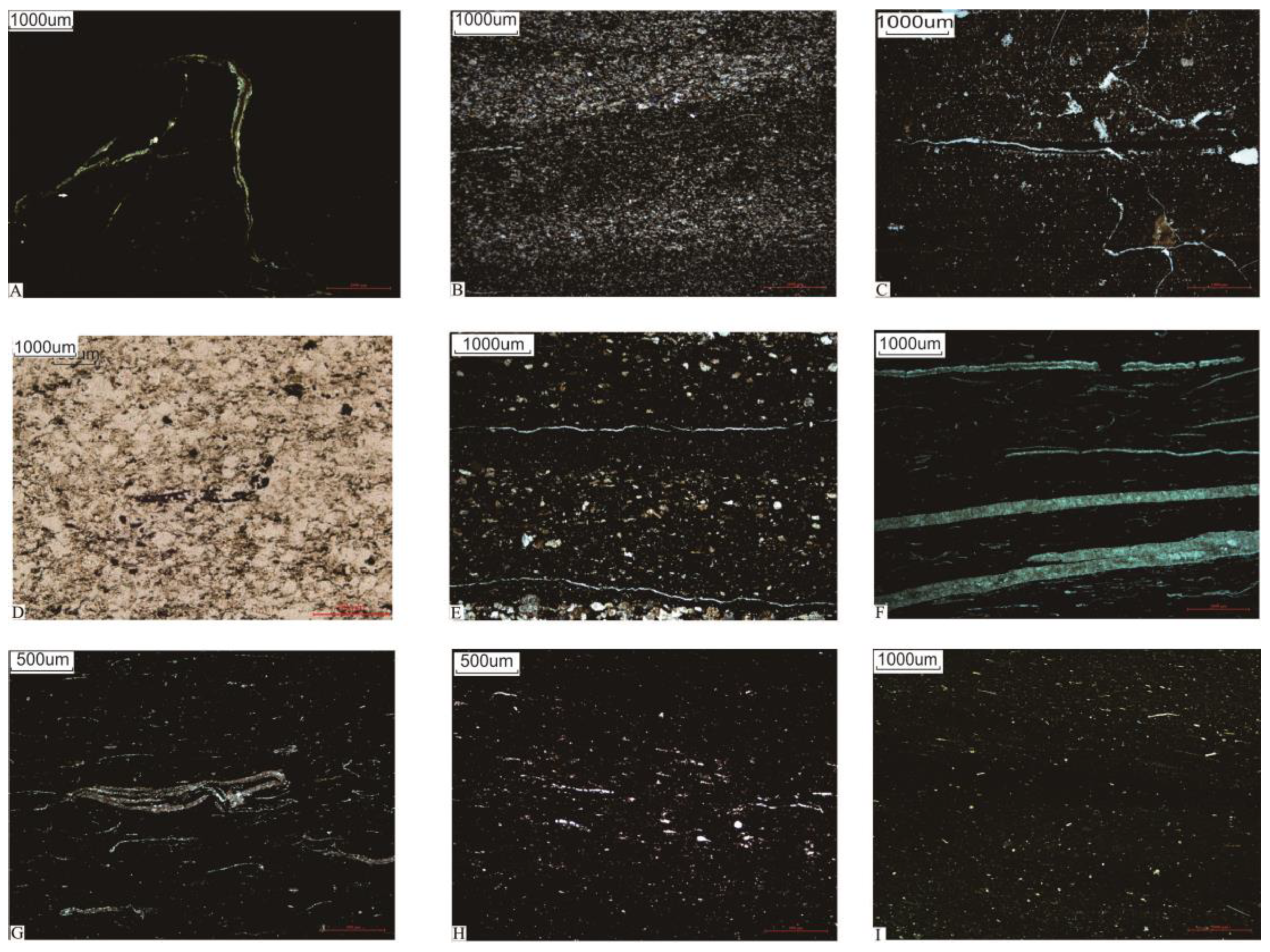
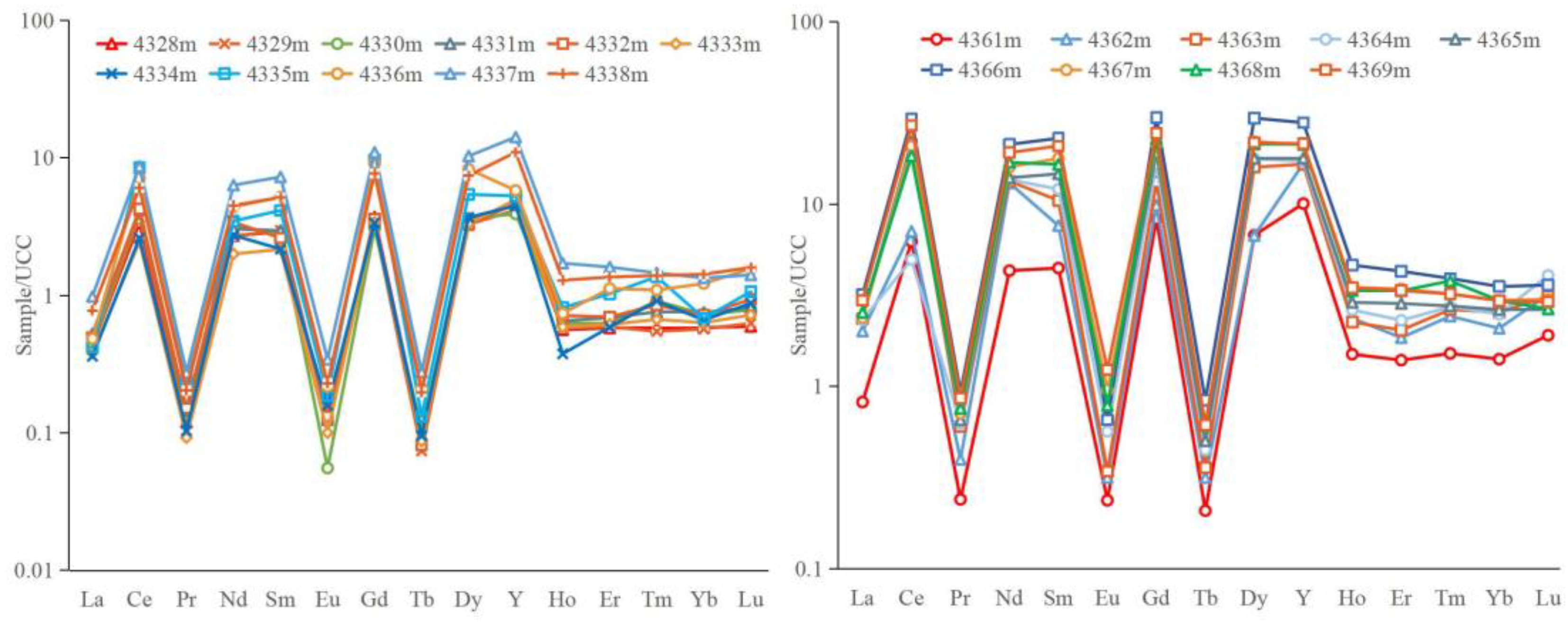

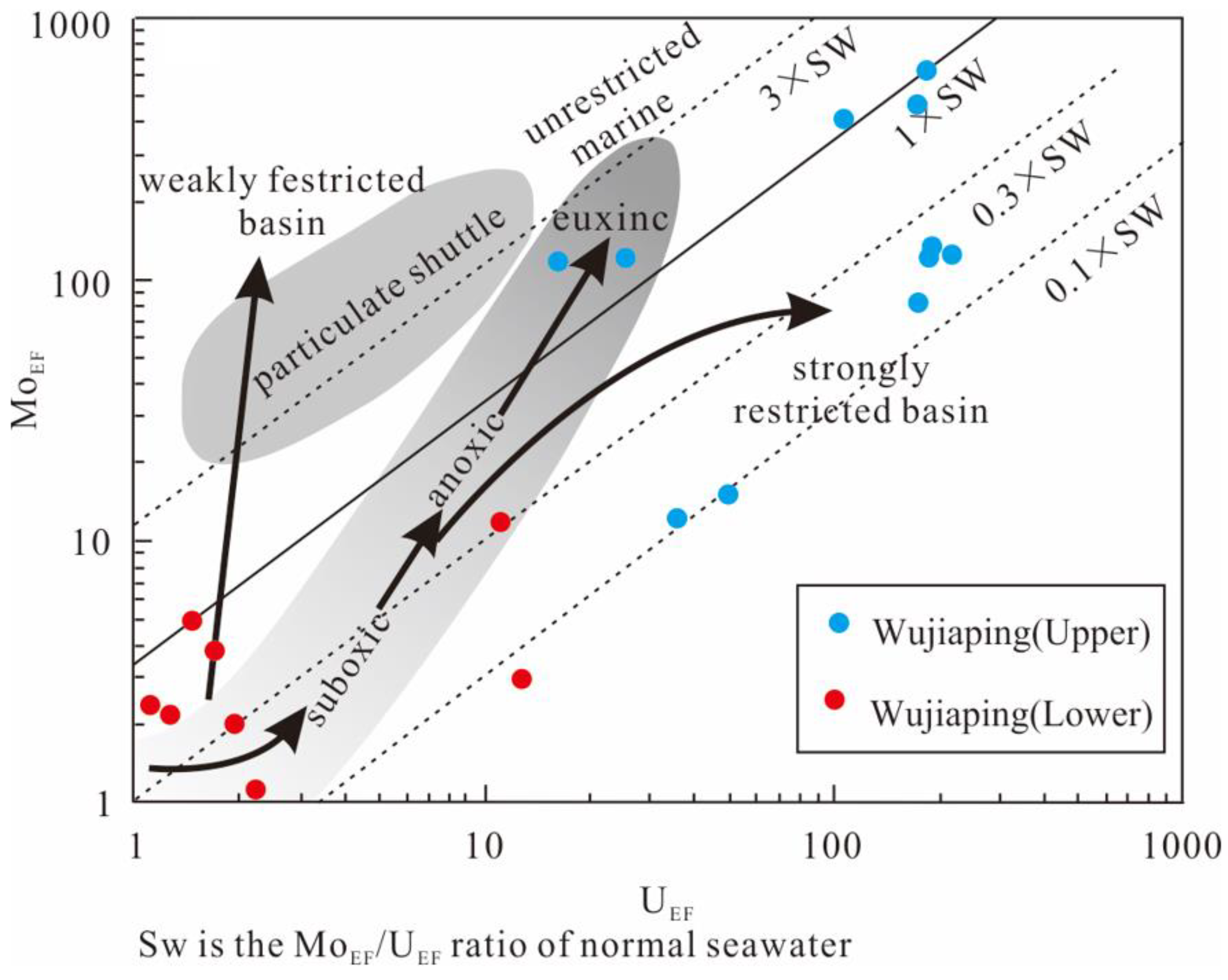

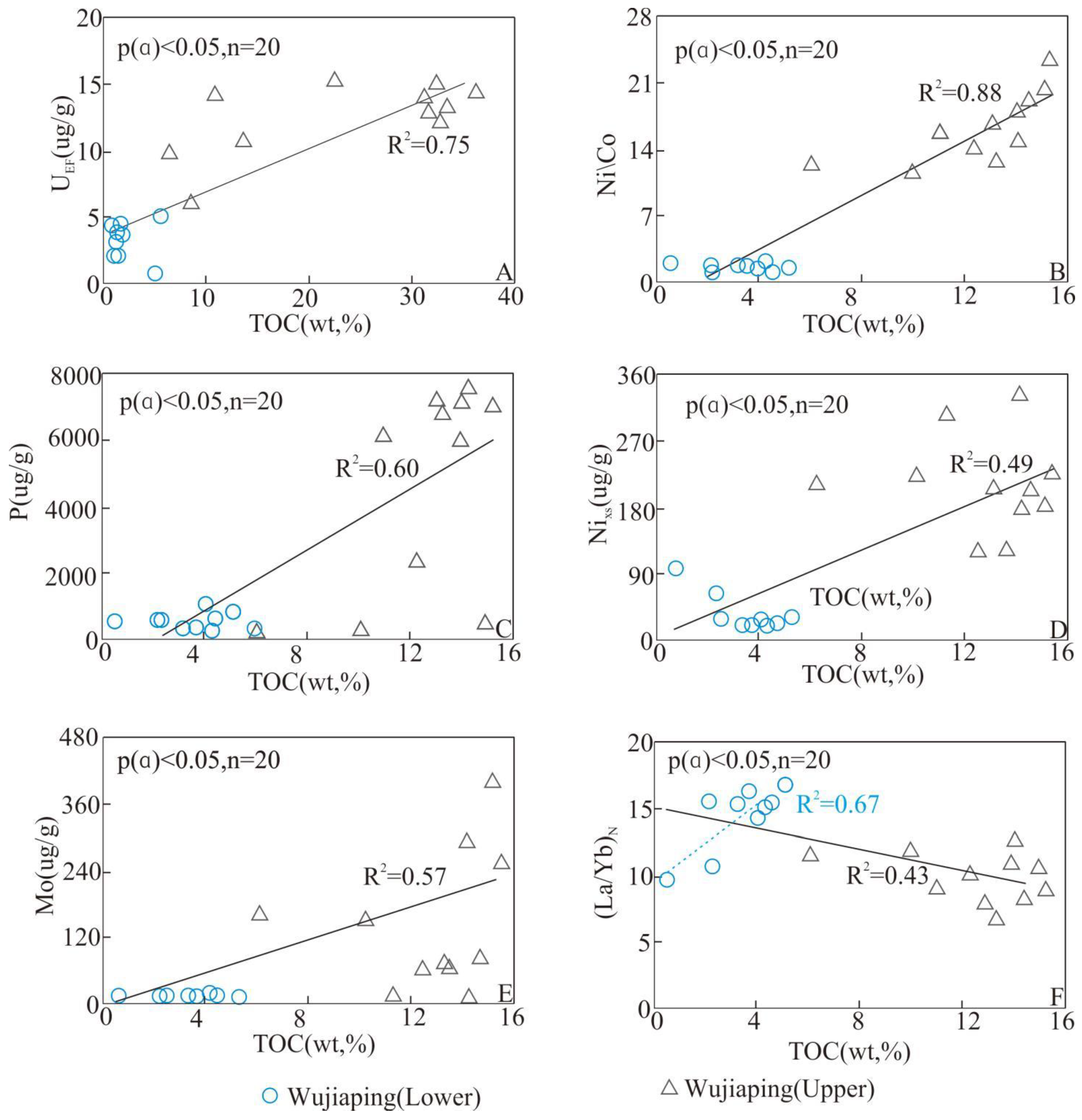
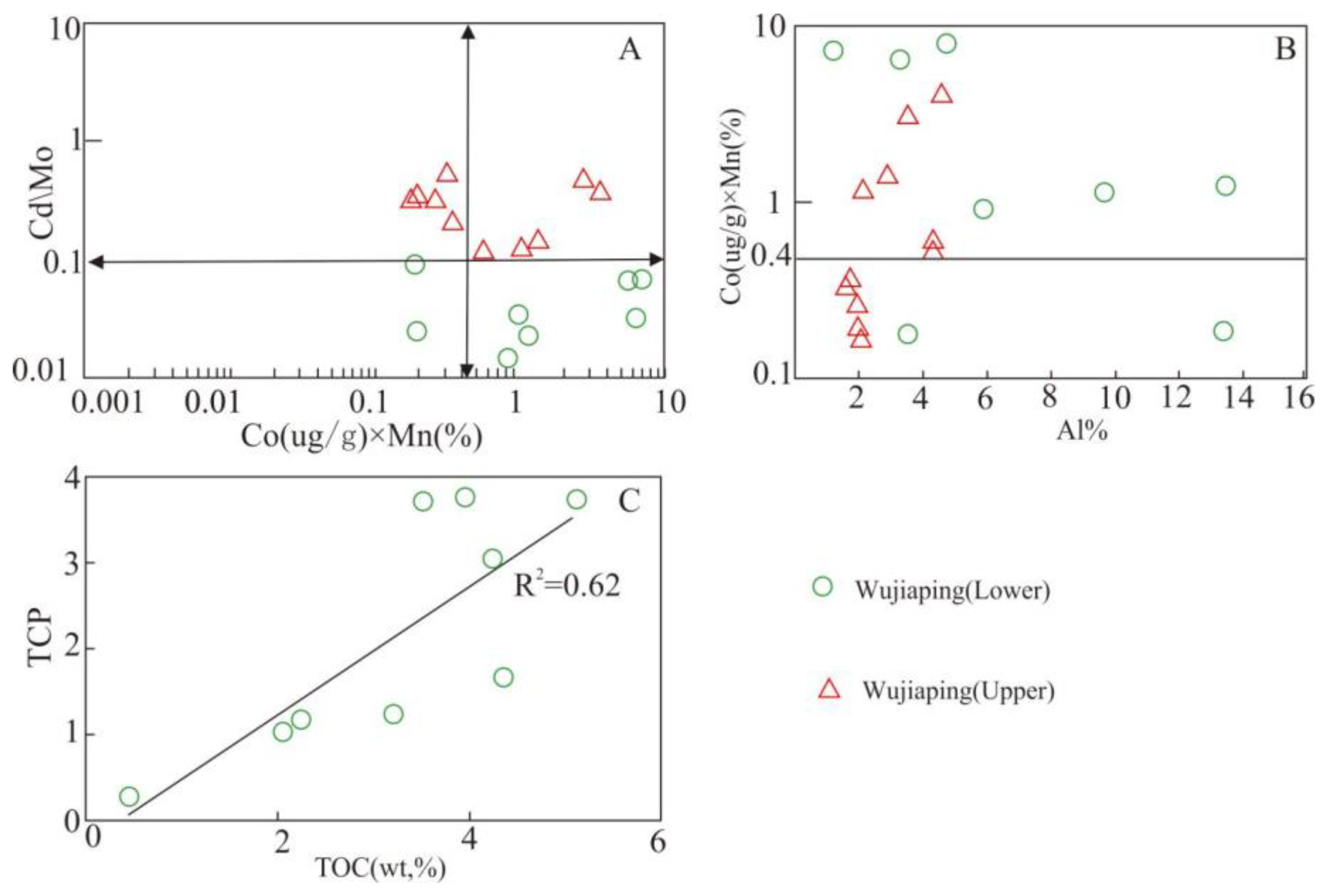
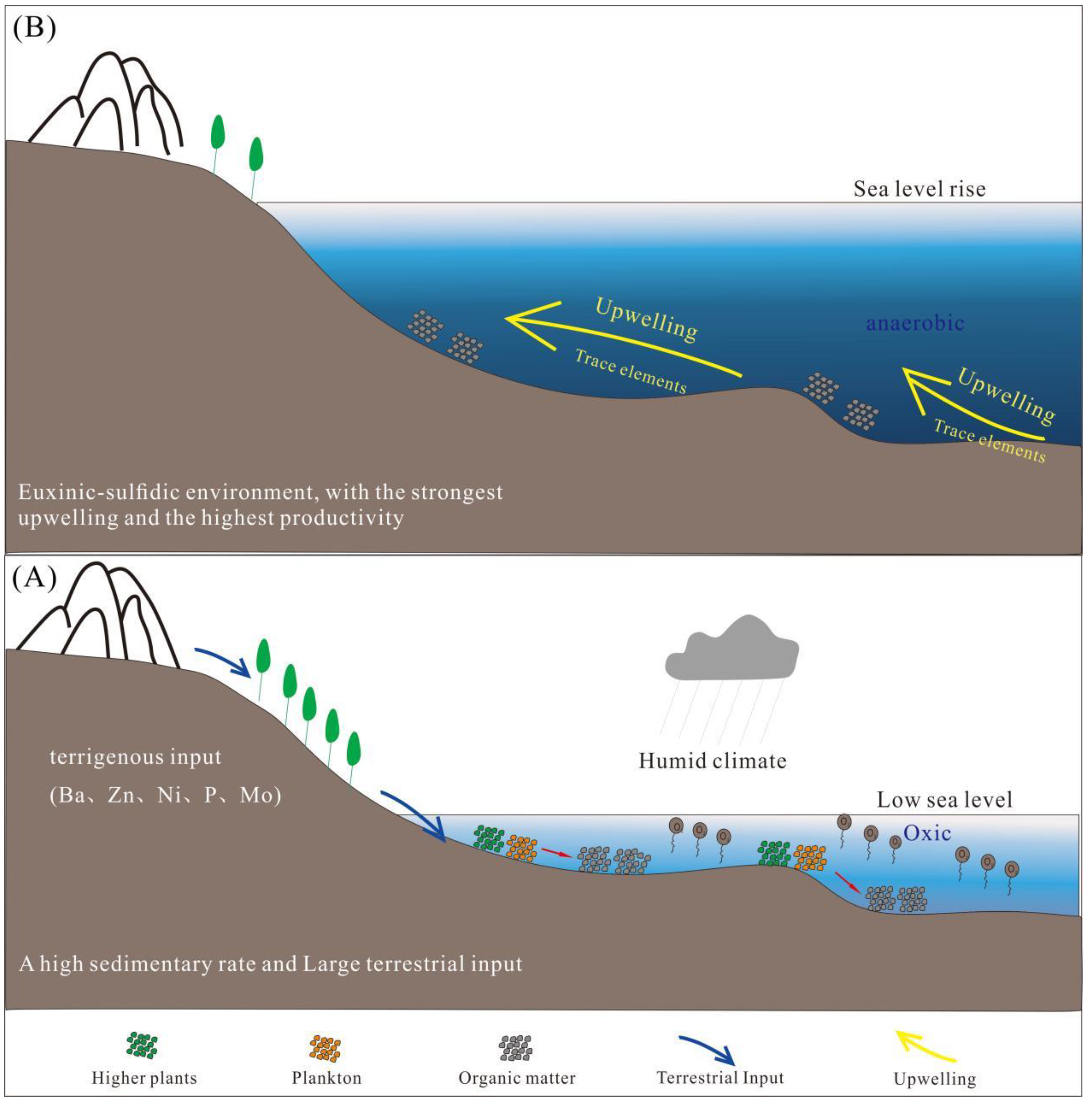
Disclaimer/Publisher’s Note: The statements, opinions and data contained in all publications are solely those of the individual author(s) and contributor(s) and not of MDPI and/or the editor(s). MDPI and/or the editor(s) disclaim responsibility for any injury to people or property resulting from any ideas, methods, instructions or products referred to in the content. |
© 2022 by the authors. Licensee MDPI, Basel, Switzerland. This article is an open access article distributed under the terms and conditions of the Creative Commons Attribution (CC BY) license (https://creativecommons.org/licenses/by/4.0/).
Share and Cite
Du, Y.; Wang, X.; Tang, R.; Zhu, Y.; Yang, C.; Zhou, H.; Pang, Q. Extraordinarily High Organic Matter Enrichment in Upper Permian Wujiaping Formation in the Kaijiang-Liangping Trough, Sichuan Basin. Energies 2023, 16, 349. https://doi.org/10.3390/en16010349
Du Y, Wang X, Tang R, Zhu Y, Yang C, Zhou H, Pang Q. Extraordinarily High Organic Matter Enrichment in Upper Permian Wujiaping Formation in the Kaijiang-Liangping Trough, Sichuan Basin. Energies. 2023; 16(1):349. https://doi.org/10.3390/en16010349
Chicago/Turabian StyleDu, Yao, Xingzhi Wang, Ruifeng Tang, Yiqing Zhu, Cong Yang, Hongfei Zhou, and Qian Pang. 2023. "Extraordinarily High Organic Matter Enrichment in Upper Permian Wujiaping Formation in the Kaijiang-Liangping Trough, Sichuan Basin" Energies 16, no. 1: 349. https://doi.org/10.3390/en16010349
APA StyleDu, Y., Wang, X., Tang, R., Zhu, Y., Yang, C., Zhou, H., & Pang, Q. (2023). Extraordinarily High Organic Matter Enrichment in Upper Permian Wujiaping Formation in the Kaijiang-Liangping Trough, Sichuan Basin. Energies, 16(1), 349. https://doi.org/10.3390/en16010349




